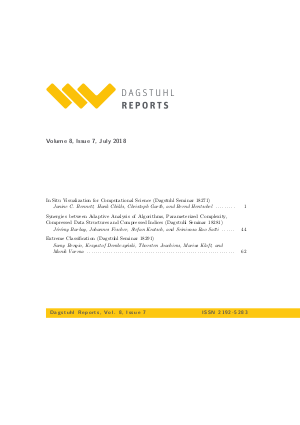Dagstuhl Reports, Volume 8, Issue 7
-
Part of:
Volume:
Dagstuhl Reports, Volume 8
Journal: Dagstuhl Reports (DagRep)

Event
- Dagstuhl Seminars 18271, 18281, 18291
Publication Details
- published at: 2019-01-22
- Publisher: Schloss Dagstuhl – Leibniz-Zentrum für Informatik
- DBLP: db/journals/dagstuhl-reports/dagstuhl-reports8
Access Numbers
- Detailed Access Statistics available here
-
Total Document Accesses (updated on a weekly basis):
0PDF Downloads
Documents
Dagstuhl Reports, Volume 8, Issue 7, July 2018, Complete Issue
Abstract
Cite as
Dagstuhl Reports, Volume 8, Issue 7, Schloss Dagstuhl – Leibniz-Zentrum für Informatik (2019)
Copy BibTex To Clipboard
@Article{DagRep.8.7,
title = {{Dagstuhl Reports, Volume 8, Issue 7, July 2018, Complete Issue}},
journal = {Dagstuhl Reports},
ISSN = {2192-5283},
year = {2019},
volume = {8},
number = {7},
publisher = {Schloss Dagstuhl -- Leibniz-Zentrum f{\"u}r Informatik},
address = {Dagstuhl, Germany},
URL = {https://drops.dagstuhl.de/entities/document/10.4230/DagRep.8.7},
URN = {urn:nbn:de:0030-drops-101788},
doi = {10.4230/DagRep.8.7},
annote = {Keywords: Dagstuhl Reports, Volume 8, Issue 7, July 2018, Complete Issue}
}
Dagstuhl Reports, Table of Contents, Volume 8, Issue 7, 2018
Abstract
Cite as
Dagstuhl Reports, Volume 8, Issue 7, pp. i-ii, Schloss Dagstuhl – Leibniz-Zentrum für Informatik (2019)
Copy BibTex To Clipboard
@Article{DagRep.8.7.i,
title = {{Dagstuhl Reports, Table of Contents, Volume 8, Issue 7, 2018}},
pages = {i--ii},
journal = {Dagstuhl Reports},
ISSN = {2192-5283},
year = {2019},
volume = {8},
number = {7},
publisher = {Schloss Dagstuhl -- Leibniz-Zentrum f{\"u}r Informatik},
address = {Dagstuhl, Germany},
URL = {https://drops.dagstuhl.de/entities/document/10.4230/DagRep.8.7.i},
URN = {urn:nbn:de:0030-drops-101777},
doi = {10.4230/DagRep.8.7.i},
annote = {Keywords: Table of Contents, Frontmatter}
}
In Situ Visualization for Computational Science (Dagstuhl Seminar 18271)
Abstract
Cite as
Janine C. Bennett, Hank Childs, Christoph Garth, and Bernd Hentschel. In Situ Visualization for Computational Science (Dagstuhl Seminar 18271). In Dagstuhl Reports, Volume 8, Issue 7, pp. 1-43, Schloss Dagstuhl – Leibniz-Zentrum für Informatik (2019)
Copy BibTex To Clipboard
@Article{bennett_et_al:DagRep.8.7.1,
author = {Bennett, Janine C. and Childs, Hank and Garth, Christoph and Hentschel, Bernd},
title = {{In Situ Visualization for Computational Science (Dagstuhl Seminar 18271)}},
pages = {1--43},
journal = {Dagstuhl Reports},
ISSN = {2192-5283},
year = {2019},
volume = {8},
number = {7},
editor = {Bennett, Janine C. and Childs, Hank and Garth, Christoph and Hentschel, Bernd},
publisher = {Schloss Dagstuhl -- Leibniz-Zentrum f{\"u}r Informatik},
address = {Dagstuhl, Germany},
URL = {https://drops.dagstuhl.de/entities/document/10.4230/DagRep.8.7.1},
URN = {urn:nbn:de:0030-drops-101714},
doi = {10.4230/DagRep.8.7.1},
annote = {Keywords: In situ processing, scientific visualization, high-performance computing, computational science, Dagstuhl Seminar}
}
Synergies between Adaptive Analysis of Algorithms, Parameterized Complexity, Compressed Data Structures and Compressed Indices (Dagstuhl Seminar 18281)
Abstract
Cite as
Jérémy Barbay, Johannes Fischer, Stefan Kratsch, and Srinivasa Rao Satti. Synergies between Adaptive Analysis of Algorithms, Parameterized Complexity, Compressed Data Structures and Compressed Indices (Dagstuhl Seminar 18281). In Dagstuhl Reports, Volume 8, Issue 7, pp. 44-61, Schloss Dagstuhl – Leibniz-Zentrum für Informatik (2019)
Copy BibTex To Clipboard
@Article{barbay_et_al:DagRep.8.7.44,
author = {Barbay, J\'{e}r\'{e}my and Fischer, Johannes and Kratsch, Stefan and Satti, Srinivasa Rao},
title = {{Synergies between Adaptive Analysis of Algorithms, Parameterized Complexity, Compressed Data Structures and Compressed Indices (Dagstuhl Seminar 18281)}},
pages = {44--61},
journal = {Dagstuhl Reports},
ISSN = {2192-5283},
year = {2019},
volume = {8},
number = {7},
editor = {Barbay, J\'{e}r\'{e}my and Fischer, Johannes and Kratsch, Stefan and Satti, Srinivasa Rao},
publisher = {Schloss Dagstuhl -- Leibniz-Zentrum f{\"u}r Informatik},
address = {Dagstuhl, Germany},
URL = {https://drops.dagstuhl.de/entities/document/10.4230/DagRep.8.7.44},
URN = {urn:nbn:de:0030-drops-101724},
doi = {10.4230/DagRep.8.7.44},
annote = {Keywords: adaptive (analysis of) algorithms, compressed data structures, compressed indices, parameterized complexity}
}
Extreme Classification (Dagstuhl Seminar 18291)
Abstract
Cite as
Samy Bengio, Krzysztof Dembczynski, Thorsten Joachims, Marius Kloft, and Manik Varma. Extreme Classification (Dagstuhl Seminar 18291). In Dagstuhl Reports, Volume 8, Issue 7, pp. 62-80, Schloss Dagstuhl – Leibniz-Zentrum für Informatik (2019)
Copy BibTex To Clipboard
@Article{bengio_et_al:DagRep.8.7.62,
author = {Bengio, Samy and Dembczynski, Krzysztof and Joachims, Thorsten and Kloft, Marius and Varma, Manik},
title = {{Extreme Classification (Dagstuhl Seminar 18291)}},
pages = {62--80},
journal = {Dagstuhl Reports},
ISSN = {2192-5283},
year = {2019},
volume = {8},
number = {7},
editor = {Bengio, Samy and Dembczynski, Krzysztof and Joachims, Thorsten and Kloft, Marius and Varma, Manik},
publisher = {Schloss Dagstuhl -- Leibniz-Zentrum f{\"u}r Informatik},
address = {Dagstuhl, Germany},
URL = {https://drops.dagstuhl.de/entities/document/10.4230/DagRep.8.7.62},
URN = {urn:nbn:de:0030-drops-101739},
doi = {10.4230/DagRep.8.7.62},
annote = {Keywords: algorithms and complexity, artificial intelligence, computer vision, machine learning}
}